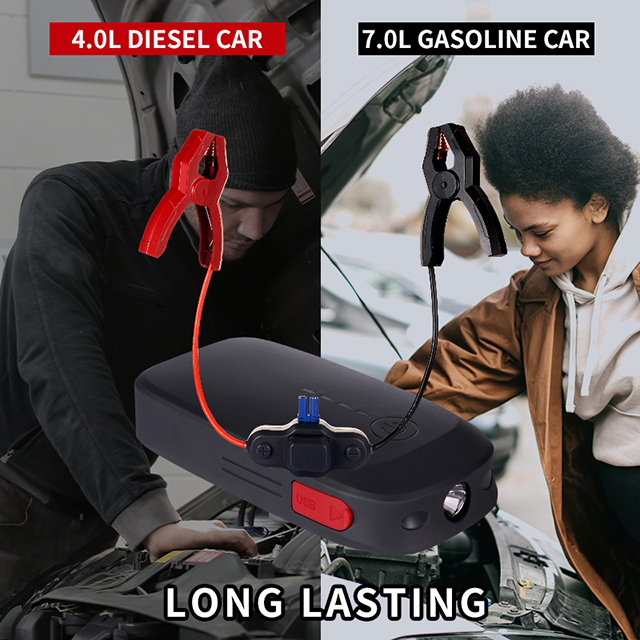Name:Brittany Zhang, Sales Manager
E-mail:brittanyl1028@gmail.com
Whatsapp:+0086 18598052187
We’ve all been there: You hop in your car, turn the key, and hear the dreaded click-click-click of a dead car battery that can no longer turn over your starter. Now you’re late for work, your coffee is cold, and frustration sets in. This is where a portable battery jump starter comes in to save the day.
No need to wait for another vehicle to assist with jumping; you can do it on your own in seconds. But which kind do you need? Is one brand better than another? And how powerful does it have to be? We put seven portable jump starters through hands-on, real-world testing to help you decide which portable jump starter is right for you.
Things to Consider When Shopping for a Jump Starter
There are two basic types of car jump starters: portable jump starters and portable power stations. Portable jump starters are small and easy to store in your trunk (or even glovebox), while portable power stations can be kept in the garage for repeated use. The question of which kind you need depends on how you’ll be using it. If you just want one to keep in the car in case of an emergency, get a portable jump starter. If you have a fleet of vehicles that need some help waking up in the morning, get a portable power station.
But how much power does your portable jump starter need for your vehicle? It can be confusing trying to decide with all of the numbers and power ratings out there, such as peak amperage, amp hours, cranking amps, and so on. Here’s the bottom line.
Peak Amperage (Current): This is the figure most manufacturers boast loudest about—but it doesn’t necessarily mean bigger is better. The higher the peak amperage rating, the more powerful a jump starter is (at least initially). For units powered by lead-acid batteries, peak amperage is an initial jolt of power that the device delivers, typically for 20-50 milliseconds, followed by 30 seconds of sustained amperage, which is categorized as Cranking Amps (CA) or Cold Cranking Amps (CCA), depending on the temperature.
However, portable jump starters with lithium-ion batteries cannot deliver high amperage for very long due to the risk of thermal runaway—a phenomenon that causes lithium-ion battery cells to go into an uncontrollable, self-heating state, which can result in fire. Most of them can only deliver high amperage for somewhere between two and five seconds, followed by a power cut rather than 30 seconds of sustained amperage.
Additionally, we reached out to the experts at Batteries Plus for some more clarification, and they said jump starters will typically list an approximate number of starts the fully charged device can complete until it needs to be recharged. In other words, a half-charged jump starter will deliver the same power, every time, until it’s drained. It just won’t deliver as many jump-starts as a fully-charged device.
Energy (Wh): The total energy that can be stored in a unit, measured in watt-hours (Wh), indicates how much juice a unit can ultimately output. The higher the number the more jump starts a unit will be able to do before needing a recharge.
Cranking Amps (CA) and Cold Cranking Amps (CCA): CA and CCA measure much lower than the peak amperage rating because they measure continuous power over 30 seconds. CA measures this at 32 degrees F, while CCA measures this at 0 degrees F. For those of us that live in cold climates, the CCA rating is especially crucial. Your vehicle’s battery also has CA and CCA ratings, typically located on the top. You’ll want a jump starter with a CA and CCA rating near (ideally above) that respective number, which is usually around 400–500 for your average passenger vehicle.
If the portable jump starter is unable to sustain high amperage for 30 seconds to meet the standards of CA and CCA, the sustained amperage output is called “Starting Amps” or something similar.
Figuring out the specs you need with these numbers can be very helpful in narrowing down which portable jump starter to buy.
How We Evaluated Jump Starters
We wheeled the ice-cold Eclipse into the Car and Driver garage and got to work. The car’s battery was so shot that, during testing, we watched its juice discharge between each test with our voltmeter. This was very handy—we didn’t have to discharge the battery manually after each jump. Once the battery discharged fully, we hooked up each unit and tried them out.
Because the car battery was drained each time we hooked a jumper to it, some of the portable jump starters would read the connection as a “reverse polarity” error (we hooked it up correctly, we promise). This was fascinating—but also unveiled a flaw with some of the new-style jump starters. Those without a manual override button would not recognize the connection, so they simply wouldn’t work. We understand the need for this fail-safe, but the inability to override the error manually and get a jolt from the unit eliminated one of the jump starters we planned to test and required another to be stabilized with a new battery in order to go back and jump-start the Eclipse—not much help if you’re stranded on the side of the road.
Along with checking if each jump starter successfully started the car, we also tested:
- Total energy it took to recharge the units from complete depletion (using a Kill-A-Watt) to sense-check the energy capacity claims
- Weight
- Ease of Use
- Lead length (measured from base of lead to end of clamp)
- Clamp quality
- Portability (for portable jump starters)
- Stability under the hood (for power stations)
- Additional features
Post time: Apr-15-2023







